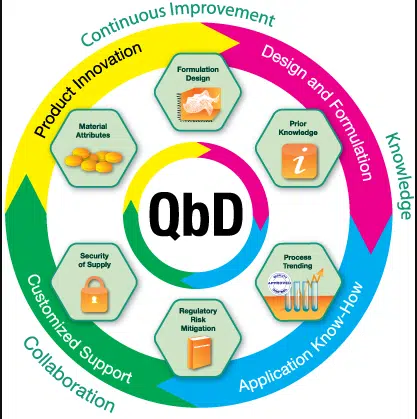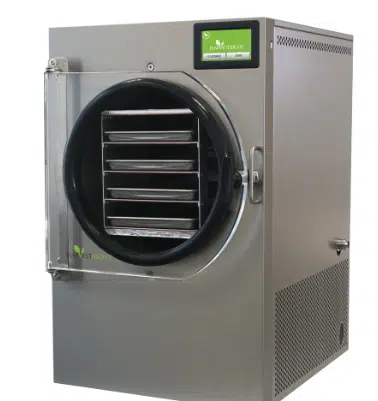Manufacture of the finished Dosage Form – QbD: New EMA Guideline
The European Medicines Agency (EMA) published its new guideline on Manufacture of the finished dosage form on August 14, 2017. The guideline replaces the “Note for Guidance on Manufacture of the Finished Dosage Form” (dated April 1996) and will enter into effect on February 14, 2018.
The following general aspects regarding the Description of Manufacturing Process and Process Controls are as below:
- A brief information regarding full manufacturing process should be provided, accompanied by a flow chart that will explain about each step of the process including in-process controls at each stage where materials enter the process.
- If a design space is used, design space should be clearly identified and described.
- The description of the manufacturing process should be adequately justified by development data, with respect to any process operating conditions or ranges. The description of a manufacturing process with wide ranges (wider than would normally be accepted as normal operating ranges) or described only by an upper or lower limit, generally requires a more thorough discussion and scientific rationale in the manufacturing process development section.
- Full scale manufacturing process validation is not requested at the time of application for certain types of products. If the result of such full scale study is not available at the time of submission, it is expected that process parameters’ settings identified during manufacturing process development are laid down in the process description. If any changes are required to the registered process parameters as a result of full scale process validation studies, these changes should be applied for via post approval variation, in accordance with the Variations Regulation.
- A product where special environmental conditions need to control during manufacture should be stated e.g. low humidity for an effervescent tablet.
- Depending on the nature of the process and the product (e.g. sterile products), manufacturing durations of critical steps and hold times should be stated and justified.
- The steps at which process controls, intermediate tests or final product controls are conducted should be identified. Need to fix to what extent the assurance of quality of the finished product is founded on the manufacturing process itself. The significance of the process description and process controls as part of the overall control strategy should be outlined based on development studies and evaluated. Every finished product manufacturing process should have an associated control strategy suitable for its intended purpose. It is expected that different control strategies may be utilized in case real time release testing (RTRT) (see also EMA Guideline on RTRT, Draft Annex 17) is proposed, a design space is claimed, a continuous manufacture or a standard manufacture is performed.
The expected level of detail in the manufacturing process description is as follows:
- The process description is expected to be considered in relation to the control strategy and the manufacturing process should be described in relevant detail (since consistent quality of a product cannot be safeguarded by end product testing alone).
- The process description should be comprehensive, including process steps in a sequential manner with batch size(s), operating principle and equipment type(s) for each unit operation .
- Equipment working capacity should be stated where appropriate. Steps in the process should have the necessary detail in terms of appropriate process parameters along with their target values or ranges.
- Where criticality is assigned to process parameters, the description of the process parameters should not only be restricted to CPPs, but also to those parameters important for manufacturing process consistency.
- Non-critical process parameters should be described at an appropriate level of detail.(The parameters that impact on quality attribute cannot be ruled out and considered to be important for the execution and consistent performance of any process step, and consequently its output)
- Any information need to used and is considered to be purely supportive should be justified and clearly identified.
- The same requirements apply to the level of detail in the manufacturing process description irrespective of the development approach, i.e. if the product has been developed by the minimal (traditional) or enhanced approach.
- In case of continuous manufacturing, the description of manufacturing process is expected to be provided in the same way.

Controls of Critical Steps and Intermediates:
- All critical steps and intermediates identified during the manufacture of the finished product should be listed including in-process controls, applied test methods and acceptance criteria.
- For complex control strategies (e.g. use of models for process control, continuous manufacturing) it should be clearly stated how release testing and product release decisions are made.
- Clear procedure for unexpected deviations from the approved manufacturing process need to describe and that process are capable to detect and manage should be provide the assure that the intended quality of the product is retained.
- A process parameter in a manufacturing step is controlled and verified to be within a range that does not affect a CQA does not make it non-critical by default. The justification for the identification of steps as critical or non-critical should be provided, including a link to experimental data in the pharmaceutical development section (e.g. risk assessment table), if applicable.
Storage of intermediate and bulk products:
- Clearing written procedure for storage is need to define and mentioned before final packaging and acceptance criteria for temperature, humidity or other environmental conditions need to mentioned. The level of information to be provided in the documentation is dependent on the nature of the bulk product.
- The maximum holding times of the bulk product or, alternatively, the maximum batch manufacturing time from start of product manufacture to completion of packaging into the final primary container for marketing should be stated, appropriately justified and supported by data.
- The reasons for any prolonged storage/processing times (e.g. more than 30 days for solid oral dosage forms and more than 24 hours for sterile products) should be stated and be consistent with GMP. Where relevant, stability data to support the holding time should be provided on at least two pilot scale batches.
- For transportation of bulk product (intermediate) between manufacturing sites guidance is given in GMP Annex 15 on how transport should be taken into consideration. The impact of short or longer excursions outside of the original storage conditions should be discussed and supported by accelerated or real time stability data.
- The suitability of the proposed bulk product (intermediate) container closure system for bulk storage (and transport if relevant) should be justified. The materials used for the bulk container closure system should be described along with the control specification for primary bulk packaging.
The European Medicines Agency (EMA) published Questions and Answers (Q&As) on “Improving the understanding of NORs, PARs, DSp and normal variability of process parameters” on July 13, 2017
Question :
What is a Normal Operating Range (NOR) and how should NORs be presented in the marketing authorization dossier?
Answer:
NOR describes a region around the target operating conditions that contains common operational variability (variability that can’t always be controlled). NORs alone are not intended to introduce flexibility in the conditions for manufacturing but they can better quantify the actual uncontrollable operational variability of process parameters and therefore should be presented in marketing authorizations as what is practically achievable.
Question:
What is a Proven Acceptable Range (PAR) and how should PARs be justified and presented in the marketing authorization dossier?
Answer:
The PAR is defined as a “characterized range of a process parameter for which operation within this range, while keeping other parameters constant, will result in producing a material meeting relevant quality criteria” (ICH Q8).
PARs could be presented in the description of the manufacturing process of the drug substance (DS) and the drug product (DP) (in S.2.2 or P.3.3 of the Module 3, respectively) as ranges. Working within the approved PAR is not considered as a change. Changes to the target value within the registered PAR can be managed under the company’s Pharmaceutical Quality System (PQS) without regulatory action. Movement out of the PAR is considered to be a change and will require a post approval change process.
Where interaction effects between different parameters exist and the acceptable range for one process parameter depends on the setting of another parameter, the parameters should be included in a Design Space.
Considerations for development (S.2.6/ P.2.3 of Module 3): Several PARs can be presented and investigated as part of the process understanding and development.
Question:
What is a Design Space (DSp) and how should DSps be justified and presented in the marketing authorization dossier?
Answer:
The DSp is defined by the “multidimensional combination and interaction of input variables (e.g., material attributes) and process parameters that have been demonstrated to provide assurance of quality“. Working within the approved DSp is not considered as a change. Movement out of the DSp is considered as a change and would normally require a regulatory post approval change process. The DSp is proposed by the applicant and is subject to regulatory assessment and approval (ICH Q8).
A DSp can be restricted by ranges of process parameters only, input material attributes only, or a combination of process parameters and input material attributes. The justification of a DSp should be presented in the development of the manufacturing process of the DS and/or DP (S.2.6 or P.2.3 of Module 3, respectively). Regarding the required level of details the following should be considered:
• Does the DSp represent parameter ranges that are much wider than what would normally be accepted as NORs?
• Does any area of the DSp represent greater risk to quality than the rest of the DSp?
• To what extent do other elements of the control strategy contribute to ensuring output material quality? Examples include in-process controls,
PAT analytics and downstream processes and controls. If it is claimed that no interaction exists between (process) parameters, this should be adequately justified. Additionally, the development of the DSp should be based on risk management principles (ICH Q9).
Question:
How to manage post-approval changes to approved DSps?
Answer:
An Extension (i.e. introduction of new material attributes or process parameters, extension of the range of existing material attributes or critical process parameters) of a DSp should be submitted as a Type II variation (B.I.e.1 or B.II.g.1).
If the change has already been described in an approved post-approval change management protocol (PACMP), depending upon what was agreed, the change can either be submitted as a Type IAin or IB notification (B.I.e.5 or B.II.g.5). According to the variations classification guideline, changes foreseen in PACMP for a biological/immunological medicinal product are Type IB.
Restrictions to an approved DSp would typically only be necessary if part of the DSp was discovered to not produce satisfactory quality material. Substantial changes to a process that may have a significant impact on the quality, safety or efficacy of the product should be submitted as a Type II variation (B.I.a.2.b or B.II.b.3.b). Some changes to specifications or process parameters can be relevant to the DSp, even if the DSp does not specifically cover these parameters. These changes should be sought in accordance with the variations classification guideline, where, depending upon the nature of the changes and type of product, some will be possible as Type IA, whereas others will be possible as Type IB notifications. The variation categories related to changes to manufacturing sites apply regardless of DSp or not. “However, the continued relevance of any registered DSp should be considered whenever there is a manufacturing site change.”
Question:
What type of process flexibility can be acceptable in the marketing authorization dossier, regardless of any mentioning of NOR, PAR or DSp?
Answer:
The EMA says, “the degree of process flexibility is dependent upon how the manufacturing process and its development is presented in the marketing authorization dossier. Irrespective of the development approach, the same requirements apply to the level of details in the manufacturing process description. Steps in the process should have the necessary details in terms of appropriate process parameters, along with their target values or ranges.”
The establishment of a DSp is optional, but, “when a flexible manufacturing process is requested (i.e. ranges of process parameters that are wider than what would be accepted as a NOR; ranges of input material attributes that can affect the quality of the process output), then the process should be established within the framework of a DSp” (see also Q/A # 3). According to the EMA, “the process description is considered to be one element of the overall control strategy that is presented in an application“. A one-sided parameter range (for example an upper range only) typically represents great flexibility and will have to be justified by scientific rationale.
Reference’s:
QbD: New EMA Guideline on Manufacture of the finished Dosage Form – ECA Academy (gmp-compliance.org)

